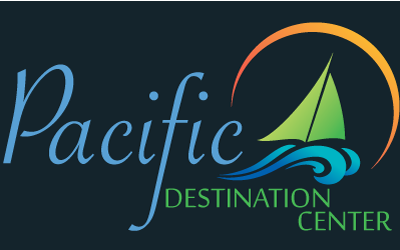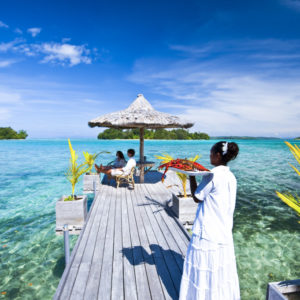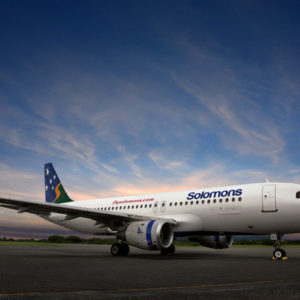Video courtesy of Solomon Islands tourism
Almost 1000 islands – The Solomon Islands are an archipelago of 992 tropical islands and atolls, scattered in a gentle curve. They comprise two major parallel island chains extending some 1800 kilometres from the Shortland Islands in the west to Tikopia and Anuta in the east.
The people – Situated in the South Pacific between Papua New Guinea and Vanuatu, the population of about 550,000 is predominantly Melanesian but includes other smaller groups. Exotic local customs and traditions remain a very important part of life for Solomon Islanders.
Unspoiled and uncrowded – The islands and waters are still a little known pristine paradise. They are particularly special for their remarkable biodiversity, containing thousands of different plant and animal species, especially the marine life. Many species are known only to the Solomon’s.
By Air
Five airlines currently provide regular scheduled services into Honiara. Solomon Airlines, Virgin Australia, Fiji Airways (formerly Air Pacific), Air Niugini and Air Vanuatu all provide international flights to the Solomons. Qantas is a codeshare partner to Solomon Airlines.
There are direct flights connecting to Honiara from Brisbane and Sydney (Australia), Nadi (Fiji), Port Moresby (Papua New Guinea) and Port Vila (Vanuatu).
Solomon Airlines is a full service carrier which flies five times weekly from Brisbane, Australia to Honiara, the capital of the Solomon Islands. The 3-hour 15-minute international flights are operated by Airbus A320 aircraft. Economy fares include meal and beverage service and a generous free checked luggage allowance of 30 kilos per passenger and 7 kilos of cabin baggage. On Saturdays, flights fly direct from Brisbane to Munda, renowned as one of the world’s most desirable dive destinations, before continuing on to Honiara. Solomon Airlines provides connections to 23 domestic destinations across the Solomon Islands. Regular flight connections from North America are available through Brisbane and also through Nadi, Fiji. Visit https://www.flysolomons.com/
Virgin Australia also fly direct from Brisbane twice a week.
From North America, most travellers fly through Los Angeles and either Brisbane or Nadi. Those travelling from European countries will most commonly fly via Brisbane with many choosing to stop over in countries such as Singpore, Hong Kong, Thailand or Dubai.
Check with the airlines for the most current and detailed flight information.
However, the country does have two distinct seasons – a wet season from November to April and a dry season from May to October. The average rainfall is approximately 2500-3000mm however it can vary from west to east across the archipelago and can also depend on the island’s topography and elevation.
Honiara has a marked wet season when on average almost 70% of the yearly total rain falls. In the dry season, on average about 100 mm falls per month compared to upwards of 300 mm in wet season months. Further to the east, Santa Cruz receives more constant rainfall during the year, averaging between 280 mm and 420 mm per month.
However, while the islands have a wet season, it’s not monsoonal with extended periods of very heavy rainfall and poor weather usually blows through fairly quickly. Cyclones aren’t common but they can occur over this time.
The drier months are generally the most comfortable period to visit when rainfall, temperature and humidity are at their lowest.
Discover ancient ceremonial sites and learn from the locals about the Solomon’s remarkable cultural heritage. Delve for relics from WWII buried in fathoms of blue green water.
This gentle arc of beautiful islands is the world’s most perfect escape. No modern distractions – just you, the sea, the sand and time. So choose from an array of activities, or simply linger in the sand and sea!
Island-hopping or dive resort – When you come diving in the Solomons you can choose between island-hopping on a live aboard boat or staying at one of the idyllic resorts specifically catering for divers. Get more dives in more destinations more quickly or enjoy the luxury of a home base.
Dive the Western Province – Dive into one of Oceania’s natural wonders. The Solomon Islands are one of the world’s top diving destinations. Dive amid the coral, starfish and swirling masses of colourful fish on spectacular reefs. Do you want to see dugongs, turtles, sharks? Come here!
Wreck diving – Diving in the Solomon Islands is an opportunity to explore an extraordinary array of ships, aircraft, even submarines – one of the highest concentrations of WWII wrecks in the Pacific. Aircraft, ships and submarines litter the sea floor and now serve as artificial reefs attracting corals and fish life as well as fascinating records of world history.
The waters just off Honiara are named Iron Bottom Sound with good reason so you don’t have to go far from the capital to experience some very memorable wreck diving. Some wrecks are shallow enough to be snorkelled.
From American oil tankers and navy destroyers to New Zealand mine sweepers and Japanese seaplanes, the diving is sensational and evokes vivid memories of WWII.
Marine life – Almost 500 species of hard and soft corals have been found to form the 5,750km 2 of reefs in the Solomon’s.
These reefs absolutely teem with life, from titan trigger fish, green and orange neon slugs and superbly colored sea fans to the full food chain of creatures including large schools of jacks and barracuda, all the way up to the cruising grey reef sharks.
The Solomon’s underwater realm provide spawning grounds and migratory routes for 1000 reef fish species, dolphins, rays, sharks, and six of the world’s seven species of marine turtles, to name a few.
There couldn’t be a better place to experience the joy and wonder of exploring under the water.
Popular dives – There are plenty of opportunities for world class snorkeling, diving and underwater photography throughout the islands but sites in the Western and Central Provinces are among the most popular.
Dive the lagoon at Marovo, the largest saltwater lagoon in the world. Many of the lagoon’s islands are uninhabited meaning the beaches are often deserted and totally unspoilt.
On the north side of the lagoon is Uepi Island, a sliver of sand and tropical jungle lined with colourful coral drop offs.
Munda and Roviana Lagoon are also popular diving destinations. Roviana is a large body of water that extends for over 50km eastwards from Munda and is bounded by a chain of barrier reefs and islands. On the outer sides of the barrier islands you’ll find walls and slopes rich in hard corals and all bathed in deep clear blue waters, back-dropped by patrolling fish.
Inside the lagoon is the Cave of the Kastom Shark, located in the mangroves of one of the many islands. A small freshwater pool is the start of a vertical shaft that leads into two large connected chambers.
The twin tunnels is another magnificent diving experience – two ancient vertical shafts on a large submerged pinnacle deep under the water. You’ll be enthralled by the swarming fish life – the large tuna, the white tipped reef sharks – as you cling to the sheer reef wall and peer over the abyss.
Leru Cut in the Central Province provides one of the Solomons’ most iconic photo opportunities. Morning sunlight pierces a chasm, the streams of light providing striking shots of divers in silhouette.
Eco Resorts – have become a major accommodation option and the islands are home to some of the Pacific’s best. Laid back eco-friendly beach bungalows sit between coconut palms, overlooking tranquil lagoons and your own sandy beach.
Cultural Village Stays – these are ideal for those wanting an authentic Solomon Islands experience. When you stay with the locals your dollar goes back into the local community, helping them with much needed essentials like food, medicine, education, and housing.
Some of our favorite accommodations in Honiara are: Solomon Kitano Mendana Hotel, Heritage Park Hotel and Coral Sea Resort Casino.
In Gizo: Fatboys Resort
In Munda: Agnes Lodge Gateway
In Marovo Lagoon: Uepi Island Resort
Showing all 2 results


